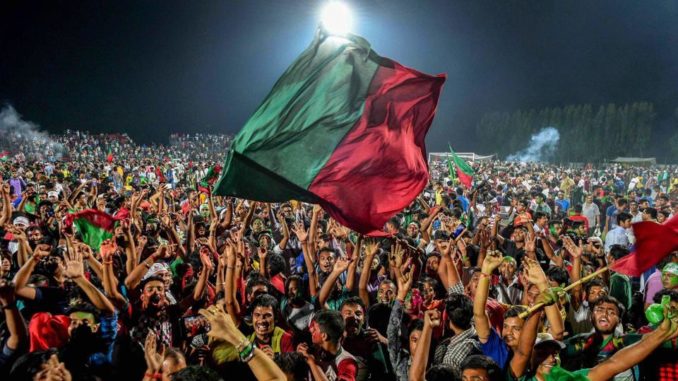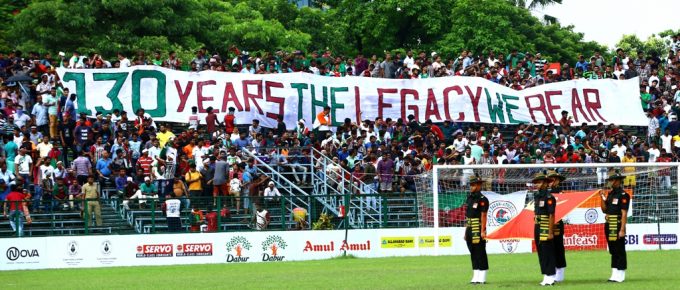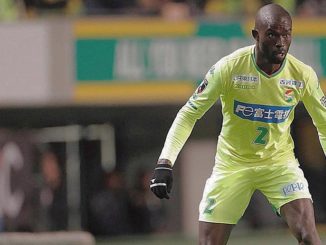
The thing with history is once it’s gone, you can’t get it back.
When an animal species is declared extinct, there’s no getting it back. When an historic building is knocked down for shiny new skyscraper, there’s no getting it back.
And when a football club as rich in history as Mohun Bagan, one of the oldest football clubs in the world, let alone India, is sold and re-branded, there is no coming back.
The architects of this merger, which will officially take place on 1 June 2020 and see the new entity participate in the 2020/21 Indian Super League, will tell you this is preserving the legacy of Mohun Bagan, a club founded in 1889. That, in any case, without this intervention the club, which has been floundering and struggling for a few years now – ironically since the introduction of the ISL – may not have survived much longer.
But make no mistake, regardless of what the corporate spin on this merger is, this is the death of Mohun Bagan as we know it.
“As much as we want the romance of the Maroon and Green jersey and it’s 130-year-old tradition to continue, there comes a time when romance almost invariably requires a partner named practicality,” said Mohun Bagan secretary Swapan Sadhan Bose in announcing the deal.
Like when Wimbledon was sold, moved and re-branded as MK Dons, it may technically have been the same club, the same entity, but the spirit and heart of the club were gone.
So it is for Mohun Bagan, without the relocation.
The Mohun Bagan name may continue in a bastardised version, with the new club to be known as ATK-Mohun Bagan, but the new owners haven’t yet committed to keeping the club’s historic logo and colours – two iconic features that are so fundamental to the identity of Mohun Bagan.
Welcome to the capitalist world of modern football, where history and tradition have a price and can be sold to the highest bidder.
“The jersey, logo and name is yet to be decided. As we said in the statement, the new football club will have brand names of ATK and Mohun Bagan,” a top ATK official was reported to have said.
Bhaichung Bhutia is a former captain of both Mohun Bagan and the Indian national team, and is regarded by many as perhaps the finest Indian player ever produced.
While he is pragmatic about the decision to merge the two clubs, he admits it would be a huge mistake if the new majority owners – RP-Sanjiv Goenka Group (RPSG) – don’t keep the Mohun Bagan name, colours and logo.
“Why would you want to have it’s name ATK-Mohun Bagan? That does not go well,” Bhutia told Indian news outlet PTI.
“That branding has to be done properly. The deal was all about buying the identity and history. With that history, you will have millions of fans across the world. That you will have to keep in mind.
“ATK are just five-six years’ old. It’s not a very old club. I don’t think ATK really have that identity. It started with Atletico de Kolkata, now it has become Amar Tomar Kolkata (ATK). I don’t think it will be a big loss for them if they lose that identity.
“That (Mohun Bagan’s) identity should not go. I don’t think Sanjiv Goenka will do that mistake because for him buying Mohun Bagan is buying an identity. If he makes that mistake of losing that identity, that will be the biggest ever loss,” the former India captain said.
“I hope that they use Mohun Bagan’s colour, logo, and the name. They should not use ATK’s colour, they should use green and maroon. They should use Mohun Bagan’s logo and name. Because it has got a rich history and heritage. I hope they can utilise that.”
While he has reservations about the aesthetics of the club, he believes this merge is ultimately the best thing for the club and Indian football.
“In fact, when I was ATK’s advisor I had actually first advised Sanjiv Goneka to buy out Mohun Bagan,” the 43-year-old said.
“Maybe the budget did not work out then. They were looking for investors. We had initiated the move then.
“I think Mohun Bagan have got a good owner. ATK are one of the best managed teams of the ISL right now. Sanjiv Goenka is one of the most visionary, successful corporate in India. They have got a very good corporate takeover. They are the best managed club in ISL right now. I think it’s a great move for Indian football.”
India has long been grappling with how to bridge the divide between the traditional I-League and the flashy, new ISL. In fact, Mohun Bagan were one of the most vocal critics against the monopoly of the corporatised ISL and the plan to give it top league status.
They were one of the six I-League clubs that wrote to Indian prime minister Narendra Modi last year asking him to “intervene and save the sport”.
The letter said, in part:
“The ISL is a purely commercial venture played by franchise-based clubs owned by the clubs. It has no relevance. More importantly, players invariably are in the 35-plus age bracket. Players who have no takers abroad are roped, leading to a decline in the standard of Indian football.
“ISL is just like the IPL of football and so the question that arises is how can a purely commercial league be made into the senior-most league of the country which has no international recognition or standing. It is a close which has no promotion or relegation.”
Further, less than 12 months ago Mohun Bagan secretary Swapan Sadhan Bose was emphatic that the club deserved to play in the top tier and would do nothing to jeapordise their history and status within Indian football.
“Indian football is at a critical crossroad,” he said in a press release. “It is a fight. For the good of Indian football, we have to fight this together.
“I will not allow anything that would tarnish the heritage or threaten the existence of our beloved club. Mohun Bagan is a club which is registered under the society act (West Bengal Societies Act). Anyone who wishes to get associated with our club must agree and respect its heritage. Therefore we are not in favour of taking any step hurriedly.”
It’s true the I-League clubs didn’t do enough to modernise themselves and their operations, leaving a hole the ISL was only too happy to fill.
Mohun Bagan has suffered badly from poor administration for many years, with a lack of sponsorship hindering their operations, which also repeatedly saw players not paid their salaries on time.
That they are in the position they are, where they need a buy out from an ISL franchise, is largely of their own making. But that doesn’t make the loss of Mohun Bagan any less significant.
Why was there not more of an effort to save one of India’s oldest and most admired clubs? Why was a merger, which will ultimately water down the history of Mohun Bagan, considered the best and only option to save the club?
To understand the significance of this, one needs to understand a little of the history of Mohun Bagan and Kolkata.
India might traditionally be known as a ‘cricket country’, but Kolkata is a hot-bed for football and the rivlary that exists between Mohun Bagan and East Bengal is one of the most fierce anywhere in Asia. The Kolkata Derby is a bucket list occasion for many football fans, myself included.
Passion runs deep on both sides of the city divide, but when the ISL was formed, with a new club in Kolkata (then known as Atletico de Kolkata after linking up with Spain’s Atletico Madrid), fans from both clubs largely dropped their club rivalries to come together in support of the new club.
For a while, the club were one of the biggest in India, winning the inaugural ISL title in 2014 and averaging 50,000 fans.
But the harmony ended when, in 2016, Goenka claimed ATK were now the city’s biggest football club.
“Have you ever seen this much frenzy for any other team in Kolkata? We are now much more popular than any other club in Kolkata,” Goenka said, stoking the fire.

Fans of both Mohun Bagan and East Bengal revolted, and attendances for ATK went plummeting, dropping to as little as 3000. In their first two seasons their lowest crowd had been 21,000.
Last year, in the Durand Cup, Mohun Bagan and ATK would face off in a competitive match for the first time, with anti-ATK banners dotted all around the stadium.
The two clubs are now one.
For their part, new owners RPSG are claiming this as a win for football in Kolkata.
“Personally, it’s an emotional reunion,” Goenka, whose father was a member of Mohun Bagan, told the Hindustan Times.
“RPSG Group, which has a 200-year-old legacy, is humbled and honoured to welcome Mohun Bagan with folded hands and open arms to the RPSG family. For me the vision is that the new club will strive to be successful not just in Bengal, not just in India but in Asia over a period of time.”
But rather than celebrating, fans in Kolkata should be mourning, for this is a sad day for Indian football as one of the oldest football clubs in the world succumbs to the capitalist world of modern football, and with it goes 130-years of history.
The question now is, who will be next?
Photo: Press Trust of India
Listen to Episode 36 of The Asian Game podcast from July 2019 as Paul discusses the long-running saga between the I-League and ISL with Indian football personality Ankush Sharma and Minerva Punjab owner Ranjit Bajaj.




